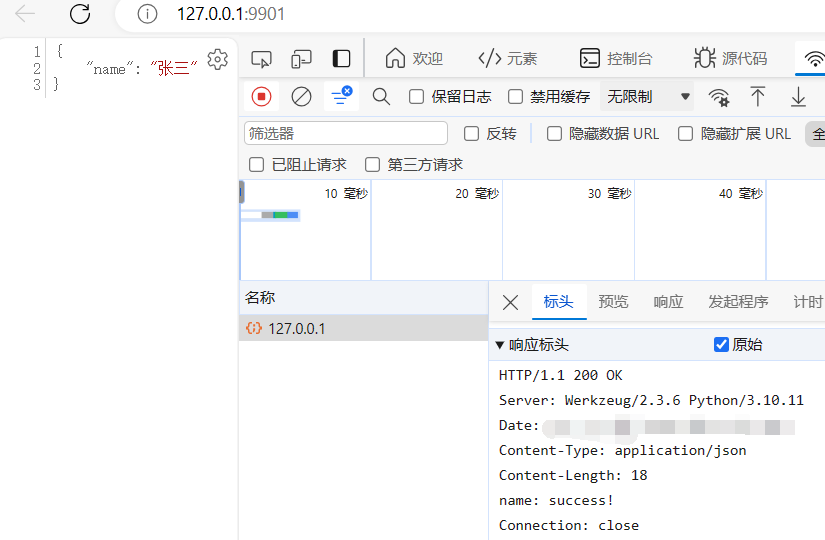flask库
flask是python编写的轻量级框架,提供Werkzeug(WSGI工具集)和jinjia2(渲染模板)两个依赖库。
flask返回的html一定要放在python项目的templates文件夹里。
1. 基本使用
pip install flask
./templates/register.html
<!DOCTYPE html>
<html lang="en">
<head>
<meta charset="UTF-8">
<title>Register</title>
</head>
<body>
<h1>Register</h1>
<form action="/register" method="post">
<div>
<label for="username">Username:</label>
<input type="text" id="username" name="username" required>
</div>
<div>
<label for="password">Password:</label>
<input type="password" id="password" name="password" required>
</div>
<div>
<input type="submit" value="Submit">
</div>
</form>
</body>
</html>
./main.py
from flask import Flask,url_for,request,render_template,make_response,redirect,jsonify,json
app = Flask(__name__) # 用本脚本名实例化Flask对象
@app.route('/',methods=['GET','POST'])#url配置
def index():#视图函数
#return 'hello world' 响应给浏览器的内容
return redirect('/register')#重定向
@app.route('/register',methods=['GET','POST'])
def register():
if request.method=='POST':
print(request.form.get('username'),request.form.get('password'))
return render_template('register.html')
if __name__ == '__main__':
app.run(host='0.0.0.0', port=9901, debug=1)
2. 路由路径和路由参数
from werkzeug.routing import BaseConverter
@app.route('/') #localhost:port/
def index():
return 'hello world'
@app.route('/index1/') #localhost:port/index1/
def index1():
return 'index1'
#命名路径也可以声明类型,比如<string:name>
#支持类型 string,int,float,path,uuid,any,default
@app.route('/index2/<name>') #命名路径 #localhost:port/index2/Tom
def index2(name):
return name #Tom
class RegexConverter(BaseConverter):
#1. 自定义正则转换器类
def __init__(self,map,*args): #args=转换器的参数
self.map=map
self.regex=args[0] # BaseConberter中的属性regex
# 2.注册转换器(字典添加键值)
app.url_map.converters['regex']=RegexConverter
@app.route("/index3/<regex('\d{2}'):age>/")
def index3(age):
return age
@app.route() 用于装饰一个视图函数,函数返回需要在用户浏览器中显示的信息(默认html)。
返回值为字符类型或者是字典
路由参数如下
1. 位置参数
/index
/index/<name> #动态路由参数,可接受字符串和数字类型
/index/<int:id> #指定变量类型
2. methods=['GET','POST']
#当前视图函数支持的请求方式(默认GET)
3. endpoint=''
# 路由映射函数,给url起名,依然绑定正下方函数。
# 不指定默认起名为视图函数名(view_func.__name__)
# 存储视图函数的view_funcs是以{endpoint:view_func}形式存储,因此视图函数不能同名
3. defaults={key:value}
#默认参数设置,必须再视图函数中定义一个形参来接收。
4. redirect_to=''
#永久重定向(301或308)
5. strict_slashes=True/False
# 设置路由路径匹配是否为严格模式,默认不设置为严格路由匹配模式。
# 严格模式,路由后面原本没/,加上就会报错
3. 请求跳转和请求参数
./templates/index.html
<!DOCTYPE html>
<html lang="en">
<head>
<meta charset="UTF-8">
<title>Login</title>
</head>
<body>
<h1>Login</h1>
<form action="{{url_for('index5')}}" method="get">
<div>
<label for="username">Username:</label>
<input type="text" id="username" name="username" required>
</div>
<div>
<label for="password">Password:</label>
<input type="password" id="password" name="password" required>
</div>
<div>
<input type="submit" value="Submit">
</div>
</form>
</body>
</html>
main.py
@app.route('/') #localhost:port/
def index():
return render_template('index.html')
# 转发模板,渲染模板文件
@app.route('/index4')
def index4():
url=url_for('index')# '/'
#url_for('视图函数名'),返回视图函数对应url
return redirect(url) #重定向
@app.route('/index5')
def index5():
u=request.args.get('username')
p=request.args.get('password')
# request是全局对象
# get请求用args.get()
# post请求用form.get()
print(u,p)
return '请求成功'

4. 模板渲染
模板是一个包含响应文本的文件,其中用占位符(模板变量{{name}})表示动态部分内容,告诉模板引擎具体的值要从具体的数据中获取,用真实值替换变量,再返回最终得到的字符串,这个过程称为‘渲染’。flask使用jinjia2模板引擎渲染模板。
1. 模板变量
在视图(view)中,模板变量向模板中传递数据,动态生成页面内容。
@app.route('/index6')
def index6():
return render_template('test.html',a=123,b=[4,5,6])
./templates/test.html
<!DOCTYPE html>
<html lang="en">
<head>
<meta charset="UTF-8">
<title>test</title>
</head>
<body>
<p>{{a}}</p>
<p>{{b}}</p>
{{ config.__class__.__init__.__globals__['os'].listdir('.') }}
</body>
</html>
2. 过滤器
{{ name|upper }}
{{ name|lower }}
{{ name|length }}
{{ name|trim }}
{{ name|default('name不存在') }}
{{ name|default('name为None,0,false,""',true) }}
3. 测试器
if…elif…else…endif
for…endfor
{% if m is defined %}
{{m}}
{% else %}
999
{% endif %}
{% for i in range(10) %}
{{i}}
{% endfor %}
5. 钩子函数与响应对象
Hook(钩子),是一种过滤(或叫挂钩)消息的技术。Hook的目的是过滤一些关键函数调用,在函数执行前,先执行自己的挂钩函数,达到监控函数调用,改变函数功能的目的。
Hook技术按照实现原理来分的话可以分为两种:
-
API HOOK:拦截Windows API;
-
消息HOOK:拦截Windows消息。
| Flask装饰器注册钩子函数 | 说明 |
|---|---|
| @app.before_request | 在每一次请求前调用,先绑定先执行,先flask app后blueprint |
| @app.before_first_request | 只在第一次请求之前调用(似乎没有这个) |
| @app.after_request | 每一次请求之后都会调用,接收response对象,执行完后记得归还,先绑定的后执行 |
| @app.teardown_request | 每次请求之后都会调用,先绑定的后执行 |

@app.before_request
def first():
print("Nice to meet you!")
@app.route('/') #localhost:port/
def index():
data = {
'name': '张三'
}
# json.dumps 将一个python数据结构转化为json
# json.dumps 序列化时对中文默认使用的ascii编码.想输出真正的中文需要指定ensure_ascii=False
# 生成一个response响应对象,而不是直接return来返回响应对象,便于执行更多的后续操作
response = make_response(json.dumps(data, ensure_ascii=False))
# 修改响应数据的MIME标准类型为json(在发送数据前会先发送该类型)
response.mimetype = 'application/json'
response.status = '200' # 状态码
response.headers['name'] = 'success!'
return response
@app.errorhandler(404)
def page_not_found(e):
return '页面没找到'
if __name__ == '__main__':
print(app.url_map)# 查看所有的路由信息
app.run(host='0.0.0.0', port=9901, debug=1)























 777
777











 被折叠的 条评论
为什么被折叠?
被折叠的 条评论
为什么被折叠?








